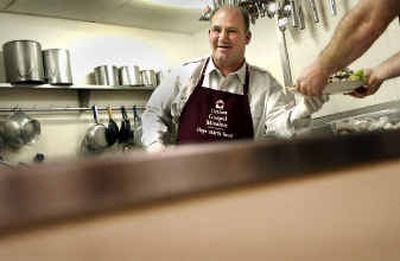Charities working smarter

On a summer evening in 1998, Chuck Fulkrug stumbled into the Union Gospel Mission – homeless, desperate and struggling with alcoholism. He had no idea his time there would lead to television.
After two years at the men’s shelter, Fulkrug went from a life on the streets to a full-time job as a security guard and a newly purchased home.
It’s the stuff of movies. Or commercials.
Fulkrug’s remarkable transition placed him at the center of a tiny but powerful marketing campaign for the homeless shelter this fall. He has starred in two television commercials and is featured in a tan, 12-page booklet documenting his life story.
“I actually thought, ‘Wow, I’ve come a long ways,’ ” said the 49-year-old Fulkrug, on his response to seeing the commercials on television. “I think it’s awesome. I want people to see what God’s done in my life.”
For the men’s shelter, Fulkrug’s story is proof that it can turn men’s lives around. Now, it wants to bring that message to potential donors as it struggles to raise money.
“We want people to know their investment pays off,” said David Wall, the shelter’s operations manager. “And we wanted to see if we can get more community awareness.”
In the post-9/11 era, the rules of fund-raising have been rewritten, as many nonprofits have tried to become increasingly self-reliant and innovative. With periodic dips in state and federal grants – as well as dependence on giant fund-raising organizations like United Way – some groups felt at the mercy of decision-makers beyond their control.
“If you have your own money, you control your destiny,” said Monica Walters, executive director of the local branch of the YWCA, which has doubled its goal for private fund-raising for 2005. “If you become dependent on those large grants, you start a program, and you can’t keep it going.”
The YWCA, which lost a $75,000 grant from the Department of Justice and more than $60,000 in United Way funding last year, has focused increasingly on local donors, meeting face-to-face with them.
“We have to become really astute at targeting those individuals who have a specific interest in helping those people we serve,” Walters said.
Since 2002, United Way’s Spokane chapter has cut nearly $750,000 from its allocations to dozens of local groups, or about 30 percent, leaving many groups searching for other sources. In Idaho, Kootenai County’s United Way has increased its allocations 27 percent for next year, but it raises only about one-fourth as much money as the Spokane group.
The terrorist attacks of Sept. 11, 2001, froze many fund-raising efforts, but today there are signs of a thaw. In 2003, charitable giving increased 2.8 percent, reaching the highest rate since 2000, according to a report from The Collins Group, a Seattle research firm that tracks nonprofits. Human services groups, however, saw little growth, the report said.
That has forced nonprofits to change their approach or risk missing their fund-raising goals. At the Spokane chapter of the Salvation Army, officials took a pragmatic look at its iconic Christmas bell-ringing program, evaluating profit margins at each of the 60 sites.
This year, the chapter reduced the number of sites to the 40 that proved most profitable. The group also did online advertising for volunteers, whose numbers have grown dramatically this year.
The approach appears to have paid off. In the first 16 days of operation, the Salvation Army received $42,000 – a 37 percent increase in net income over last year.
“We wanted to work smarter rather than harder,” said Christy Markham, the group’s spokeswoman.
The Union Gospel Mission, which advocates a Christian-based recovery program, has long shied away from, or been ineligible for, public funding. Instead, it relies heavily on individual donors.
Several years ago, when Wall first approached the shelter’s board of directors about a marketing campaign, some expressed apprehension about spending money to raise money.
But this fall, Wall stretched a $20,000 marketing campaign into a series of radio and television spots, relying on friends to help with filming and editing. He convinced television stations to provide two commercial slots for the price of one. A local billboard company also gave him a deal that allowed the shelter to place several towering signs around the region.
“How do you measure how effective a billboard is? Or a television spot? Or a radio ad?” Wall asked.
He shrugged his shoulders. But later, he held up a $17 check with an attached note that read in part, “Your billboard campaign is a very powerful message.”
The billboards, which show a homeless man in prayer, “remind people of a brother or a dad who they can’t imagine being homeless or on the street,” Wall said.
While November looked promising, much of the shelter’s private donations come in the final weeks of the year, he said.
Fulkrug, who now volunteers at the shelter serving lunch, said he is proud of the commercials, though he has taken some good-natured ribbing at the hands of friends at the shelter.
In one commercial, he guides the camera to a garbage bin, where he once foraged for food, then down an alley to show where he slept.
The commercial – like Fulkrug’s life story – has a happy ending.
“I’ve got my own house, my own job, and my own truck,” Fulkrug said. “It shows people, ‘Hey, if I can do it, they can do it.’ “